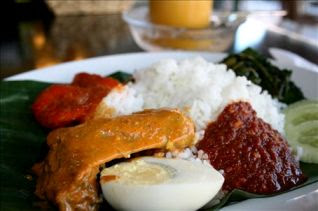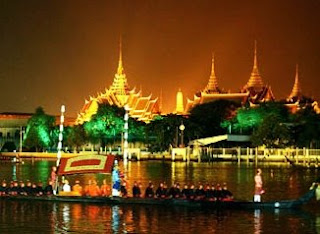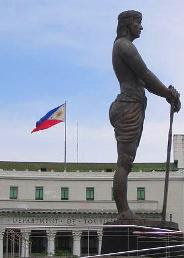
You’re probably familiar with the Malaysian Tourism ad slogan “Malaysia, Truly Asia” and may have even sniggered once or twice at how cheesy it sounds. But actually, when you visit the bustling metropolis of Kuala Lumpur and walk around the city centre, you realize just how apt the description actually is, and how pleasant the country can be for the same very reason. Colorful Malay dress such as baju kurung blend in with corporate suits, Chinese cheongsam and the Indian “Punjabi” style pant-suit called the shalwar kameez. Diverse, loud, and perhaps a little overbearing at first to the inexperienced tourist, Kuala Lumpur (KL) is indeed a melting pot of ethnicity and culture. And besides the bright dress sense of Malaysians, this fact is also best illustrated in the nation’s passion for food (makan). While every Malaysian will have their own opinion of where to find the best Char Kway Teow or Nasi Lemak in the city, I’ve listed a few for you to sample. Got better ideas? Let's Share!
Classic Malaysian dishes:
Nasi Lemak is the unofficial Malaysian national dish and comprises of rice steamed in coconut milk, roasted peanuts, a hard-boiled egg, anchovies and the essential piquant sambal (a red sauce made with shrimp paste). It’s also often served with spicy chicken (ayam percik). While you can find Nasi Lemak virtually anywhere (even on the Air Asia menu) in Malaysia, the rumored “best” places around KL are:
- Nasi Lemak Antarabangsa, 4 Jalan Raja Mudu Musa, Kampung Baru (+603 2931 1358)
- Madam Kwan’s restaurants: 65, Telawi 3, Bangsar Baru,(+603 2284 2297) and Level 4, Suria KLCC, +603 2026 2297)
Chicken Rice is widely served and relished in Malaysia. Despite the fact that Singapore has claimed it as “their” state dish, it comes from the ethnic Hainanese Chinese who populated both Malaysia and Singapore. The dish is characterized by its “oily rice” which is cooked in stock from the chicken.
- Nasi Ayam Laily, located at the SS15 Subang Jaya Food Court
- The Chicken Rice Shop, Lower Ground Floor, Mid Valley Megamall (+603 2287 9290)http://www.midvalley.com.my/thechickenriceshop/
Nasi Lemak is the unofficial Malaysian national dish and comprises of rice steamed in coconut milk, roasted peanuts, a hard-boiled egg, anchovies and the essential piquant sambal (a red sauce made with shrimp paste). It’s also often served with spicy chicken (ayam percik). While you can find Nasi Lemak virtually anywhere (even on the Air Asia menu) in Malaysia, the rumored “best” places around KL are:
- Nasi Lemak Antarabangsa, 4 Jalan Raja Mudu Musa, Kampung Baru (+603 2931 1358)
- Madam Kwan’s restaurants: 65, Telawi 3, Bangsar Baru,(+603 2284 2297) and Level 4, Suria KLCC, +603 2026 2297)
Chicken Rice is widely served and relished in Malaysia. Despite the fact that Singapore has claimed it as “their” state dish, it comes from the ethnic Hainanese Chinese who populated both Malaysia and Singapore. The dish is characterized by its “oily rice” which is cooked in stock from the chicken.
- Nasi Ayam Laily, located at the SS15 Subang Jaya Food Court
- The Chicken Rice Shop, Lower Ground Floor, Mid Valley Megamall (+603 2287 9290)http://www.midvalley.com.my/thechickenriceshop/
Char Kuay Teow
Stir-fried in a extremely hot wok (preferably with the charred remains of previously cooked meals for added flavor), Char Kuay Teow comprises flat rice noodles, dark soy sauce, prawns, bean sprouts, cockles and egg, and is most famous in the Malaysian state of Penang. You can find this classic hawker dish throughout KL, but for the Penang style try:
- O & S Restaurant, the corner shop house facing the Caltex petrol station, Jalan 20/14, Paramount Gardens, Petaling Jaya
- Chow Yang (aka Cheow Yang), 157 Jalan SS 2/6, Petaling Jaya
- All Penang Village branches http://penangvillage.com.my/contact_main.html
Curry and Assam Laksas
These famous soupy noodle dishes are a must-have in Malaysia and different states have their own versions. The two main types are: Curry Laksa which is made with coconut milk, and Assam Laksa, which is a sour-fish based broth that uses tamarind. The former often comes with thick yellow noodles, tofu, bean sprouts and chicken, prawns or egg while the latter is served with rice vermicelli, shredded cucumber, pineapple and bite-size pieces of fish. Try these in KL:
- Aunty Nat, The Boulevard, Mid Valley Megamall, (603) 2283 5339
- Sri Melaka Nyonya Restaurant, 11 Jalan 52/8, Petaling Jaya, (603) 7956 3497
- Penang Village branches http://penangvillage.com.my/contact_main.html
Satay
Foreigners often confuse satay as being a Thai dish, but it originated from Malaysia. It’s such a renowned favorite that it needs little explanation. Basically, the skewered meat is marinated in coconut milk, tamarind paste, turmeric, ginger and other spices and then cooked over a charcoal grill. It is served with a peanut spicy sauce. In KL, satay can be found commonly in front of Mamak stalls (cafes run and teamed by Indian Muslims) and many food courts or hawker areas. But you can also try:
- Restoran Maju Garuda, 36B, Jalan Raja Alang, Kampung Baru (603) 2691 4077
- Sate King branches http://www.sateking.com/
Banana Leaf
A visit to KL would not be complete without “daun pisang”, otherwise known as banana leaf. Served on the said foliage, an order of banana leaf consists of rice and a series of chutneys, vegetables, dahl, sambar, curries, papadums, yam chips and meat, fish or tofu. You sit down and are literally swarmed by men from all directions piling things up on your splayed green leaf. You can choose from different curry masalas to pour over your rice and are offered fried, tandoor or curried meat and vegetarian options in addition to little metal cups of soup (rasam) and yoghurt. Expect to be overfed, overwhelmed but extremely satisfied. Try these classic venues:
- Sri Nirwana Maju, 43 Jalan Telawi 3, Bangsar Baru (603) 6028 3526.
- Sri Paandi both Brickfields (254, Jalan Tun Sambathan,
(603 2274 0464) and PJ (Jalan 11/4, Jalan Dato' Mahmud) branches
- Lotus Family Restaurants (especially the branch on Jalan Gasing)
http://www.lotusgroup.com.my/
- Devi’s Corner (Jalan telawi 5, Bangsar)
- ask any taxi or local and they will know this place
Mamaks and Hawker stalls
Mamak cafes or restaurants are found on almost every corner, in every suburb, of every town in Malaysia. Mamak in Malay language means Indian Muslim and they are usually owned by Malaysian Indians and staffed by Indian immigrants. Serving a wide array of foods of Indian and Malay styles, these cafes are brimming with people at all sorts of hours as many are 24 hours. Typical foods ordered at a mamak stall wuuld be thosai and roti canai (both savoury pancake style breads) served with curry, nasi goreng (fried rice), mee goreng (fried noodles) and there is always a selection of hot dishes available in buffet style for self service. The mamaks are also famous for serving teh tarik which is a source of pride across the country. Translated into English, teh tarik is “pulled tea” – which reflects the technique used to make it. Tea is poured from one hand held container to another with condensed milk to produce a frothy effect. It is quite an elaborate artform and Malaysians are so keen on this drink and there are fierce national competitions for the teh tarik masters title. There was even, at one point, talk about performing the feat on the moon with the country’s inaugural space mission.
Hawker stalls are found throughout the many suburbs of Malaysia, usually in large food court style areas. From fried noodles, soups, to rice dishes and fried meats and tofu, hawkers cover a range of foods. In downtown KL, the street of Jalan Alor is famous for is eclectic hawker selection, as is Central Market Hawker Stall (Top floor, Jalan Hang Kasturi, Kuala Lumpur), the Ampang Park Shopping Complex Food C ourt (Jalan Tun Razak, Kuala Lumpur) and Brickfields outdoor hawker area (Jalan Tun Sambathan, Kuala Lumpur).
Stir-fried in a extremely hot wok (preferably with the charred remains of previously cooked meals for added flavor), Char Kuay Teow comprises flat rice noodles, dark soy sauce, prawns, bean sprouts, cockles and egg, and is most famous in the Malaysian state of Penang. You can find this classic hawker dish throughout KL, but for the Penang style try:
- O & S Restaurant, the corner shop house facing the Caltex petrol station, Jalan 20/14, Paramount Gardens, Petaling Jaya
- Chow Yang (aka Cheow Yang), 157 Jalan SS 2/6, Petaling Jaya
- All Penang Village branches http://penangvillage.com.my/contact_main.html
Curry and Assam Laksas
These famous soupy noodle dishes are a must-have in Malaysia and different states have their own versions. The two main types are: Curry Laksa which is made with coconut milk, and Assam Laksa, which is a sour-fish based broth that uses tamarind. The former often comes with thick yellow noodles, tofu, bean sprouts and chicken, prawns or egg while the latter is served with rice vermicelli, shredded cucumber, pineapple and bite-size pieces of fish. Try these in KL:
- Aunty Nat, The Boulevard, Mid Valley Megamall, (603) 2283 5339
- Sri Melaka Nyonya Restaurant, 11 Jalan 52/8, Petaling Jaya, (603) 7956 3497
- Penang Village branches http://penangvillage.com.my/contact_main.html
Satay
Foreigners often confuse satay as being a Thai dish, but it originated from Malaysia. It’s such a renowned favorite that it needs little explanation. Basically, the skewered meat is marinated in coconut milk, tamarind paste, turmeric, ginger and other spices and then cooked over a charcoal grill. It is served with a peanut spicy sauce. In KL, satay can be found commonly in front of Mamak stalls (cafes run and teamed by Indian Muslims) and many food courts or hawker areas. But you can also try:
- Restoran Maju Garuda, 36B, Jalan Raja Alang, Kampung Baru (603) 2691 4077
- Sate King branches http://www.sateking.com/
Banana Leaf
A visit to KL would not be complete without “daun pisang”, otherwise known as banana leaf. Served on the said foliage, an order of banana leaf consists of rice and a series of chutneys, vegetables, dahl, sambar, curries, papadums, yam chips and meat, fish or tofu. You sit down and are literally swarmed by men from all directions piling things up on your splayed green leaf. You can choose from different curry masalas to pour over your rice and are offered fried, tandoor or curried meat and vegetarian options in addition to little metal cups of soup (rasam) and yoghurt. Expect to be overfed, overwhelmed but extremely satisfied. Try these classic venues:
- Sri Nirwana Maju, 43 Jalan Telawi 3, Bangsar Baru (603) 6028 3526.
- Sri Paandi both Brickfields (254, Jalan Tun Sambathan,
(603 2274 0464) and PJ (Jalan 11/4, Jalan Dato' Mahmud) branches
- Lotus Family Restaurants (especially the branch on Jalan Gasing)
http://www.lotusgroup.com.my/
- Devi’s Corner (Jalan telawi 5, Bangsar)
- ask any taxi or local and they will know this place
Mamaks and Hawker stalls
Mamak cafes or restaurants are found on almost every corner, in every suburb, of every town in Malaysia. Mamak in Malay language means Indian Muslim and they are usually owned by Malaysian Indians and staffed by Indian immigrants. Serving a wide array of foods of Indian and Malay styles, these cafes are brimming with people at all sorts of hours as many are 24 hours. Typical foods ordered at a mamak stall wuuld be thosai and roti canai (both savoury pancake style breads) served with curry, nasi goreng (fried rice), mee goreng (fried noodles) and there is always a selection of hot dishes available in buffet style for self service. The mamaks are also famous for serving teh tarik which is a source of pride across the country. Translated into English, teh tarik is “pulled tea” – which reflects the technique used to make it. Tea is poured from one hand held container to another with condensed milk to produce a frothy effect. It is quite an elaborate artform and Malaysians are so keen on this drink and there are fierce national competitions for the teh tarik masters title. There was even, at one point, talk about performing the feat on the moon with the country’s inaugural space mission.
Hawker stalls are found throughout the many suburbs of Malaysia, usually in large food court style areas. From fried noodles, soups, to rice dishes and fried meats and tofu, hawkers cover a range of foods. In downtown KL, the street of Jalan Alor is famous for is eclectic hawker selection, as is Central Market Hawker Stall (Top floor, Jalan Hang Kasturi, Kuala Lumpur), the Ampang Park Shopping Complex Food C ourt (Jalan Tun Razak, Kuala Lumpur) and Brickfields outdoor hawker area (Jalan Tun Sambathan, Kuala Lumpur).







